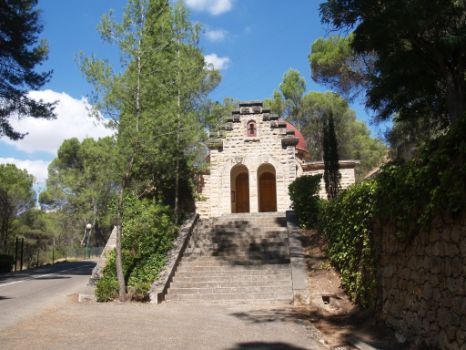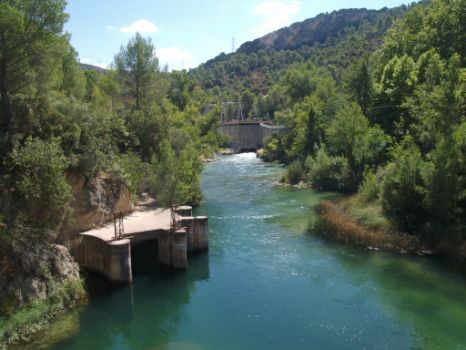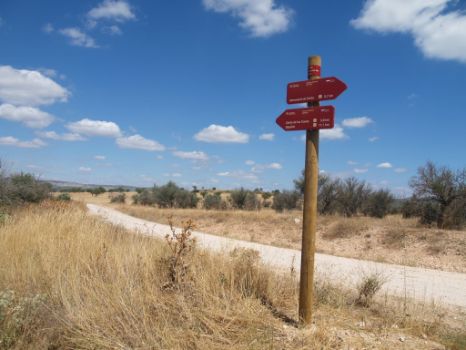Net of Natural
Trails

Stage 14: Sayatón a Zorita de los canes
Description
Near Zorita power plant
This Stage runs from the village of Sayatón to the vicinity of the impressive Zorita nuclear power plant. The unique course of the Bolarque can be seen during the pleasant walk, which takes the Trail back to the lowlands of the Tagus towards the town of Zorita de los Canes.
This Stage begins in the town of Sacedón, climbing down the road to the interStage with CM-2009. Before arriving at the junction, there is a fountain to the left, although the water may be untreated.
From the interStage, the path ventures close to a quiet road between Sayatón and Bolarque Waterfall, through a pleasant environment, in the shadow of the trees that cover the mountain. Along the path are amazing buildings associated with the waterfall and the electrical substation. Notable is the church to the left with an impressive dome covered with red tiles. The Trail now traverses through the Altomira Site of Community Importance (SCI) and Special Protection Area for Birds (SPA).
In the next stretch, the road is devoid of shade for several kilometres; therefore, it is advisable to stock up on water when near the Bolarque Waterfall. Leaving the town behind via the GU-226, along which the path continues for approximately two kilometres, it then turns right onto farmland that is clearly marked with imaginary lines.
Following the sign, the Trail reaches a junction from where one may take an offshoot road (clearly indicated) to visit Almonacid de Zorita, a beautiful town located down a wide track flanked by olive groves and a few areas reforested with Aleppo pine forests (Pinus halepensis). This road runs about 2.5 km along the Cifuentes Barca path.
The famous Zorita nuclear power plant becomes visible on the horizon. The traveller may even come across one of many flocks of sheep grazing in these meadows. The main path disappears near the interStage where the road to Almonacid began, only to reappear again one kilometre further, after crossing the paved road of the town near the nuclear plant, where it crosses the CM-200. It is advisable to use a vehicle in this Stage for safety reasons.
This Stage continues along the westbound track, leaving behind the village, to proceed towards the town of Zorita de los Canes along a well-marked path. Near the town, an interesting bridge can be seen to the right, unfinished at the time of drafting this guide, of which only the pillars stand. However, the one thing that really stands out at the edge of Zorita de los Canes is the impressive ruins of the Mozarab castle, which stands atop the town like a crown. One can find shelter under the shade and fresh water in the town’s fountains. It also has several information signs about the ruins of the castle and the Recópolis Archaeological Park, which is included in Stage 15 of this guide.
Sites of interest
Profile

Highlights
Further information
Zorita Nuclear Power Plant
This was the first nuclear plant built in Spain, next to the River Tagus, in the municipality of Almonacid de Zorita (Guadalajara). Having outlived its operating cycle, the Ministry of Industry, Tourism and Trade mandated its definitive shutdown on April 20, 2006, and disconnected the plant from the grid on April 30, 2006. The decommissioning of the plant began at that point.
Building work begun in July 1956, and was completed in record time in March 1968. The core was loaded and initial criticality was reached in June 1968. The official opening took place on December 12, 1968. It had an installed capacity of 150 MW with a pressurised water reactor. The mixed cooling system combined cooling towers and water from the Zorita Reservoir on the River Tagus.
Zorita de los Canes
The origins of Zorita are tied to its castle (declared a Historical-Artistic Site in 1931). The first written reference dates from 886, when Calib Ben Hafsum's domains extended until Zorita, from where he plundered the lands of Toledo, taking over Caliph Abd al-Rahman III. The fort was later conquered by the Christian King Alphonse VI, who named Minaya Alvar Fanez, a friend and lieutenant of the Cid, as the head of the government.
It was given to the Order of Calatrava in 1174 to defend the area against the Muslims stationed at Cuenca. In the late twelfth and early thirteenth centuries, Zorita was the "Seat" of the Order of Calatrava (1211-1212), after the loss of Calatrava and Salvatierra.
With the rise of the absolute monarchy, Zorita was alienated and Philip II sold the town in 1565 to Ruy Gomez de Silva, Duke of Pastrana. In 1572, he established an entailed estate that included Zorita and its castle. It was later passed to his son Rodrigo de Silva and Mendoza, and subsequent male heirs of the Duke of Pastrana until 1732, when the Dukes of the Infantado sold it to Juan Antonio Perez de la Torre, a predecessor of the Count of San Rafael.





